Over Wintering Hoop House Greenhouse
I have enjoyed reading about the greenhouses run by local garden bloggers. I thought I would share a post on our greenhouses. We have two greenhouses. First some information about our over wintering hoop house.
In 1997, my husband started a small backyard nursery specializing in salvias. Salvia is one of the largest plant genus with over 1000 different species worldwide. We have traveled throughout the world to see salvias in the wild. We made annual trips to the Salvia plant sale at Cabrillo College in Santa Cruz and trips to hear plant talks by other Salvia enthusiasts. We did not open to the public but instead sold at many of the local plant sales.
Propagation took several months to be ready for the Spring sales. Cuttings were taken in July-August and needed to be wintered over. The first couple of years, he had cold frames which did okay but he needed better protection.
In 1999, he purchased a 16’x21′ double poly hoop house from Steuber Distributing in Snohomish. It is built with galvanized steel pipe hoops covered with double plastic which has an inflator that creates an insulation layer by blowing air between the two plastic layers. It also came with the framing for the end-walls, doors and vents. He used corrugated fiberglass sheeting for the end-walls and added winter insulation by covering the end-walls with two layers of bubble wrap covered with plastic. There are removable plywood sidewalls at the bottom of the hoops which are removed in the summer for venting. At the time, it cost only about $1000.00 and he assembled it himself.
He closed the nursery in 2007. Today, it is mainly over an wintering greenhouse.
He learned a lot over the years. He heated it at first with just an electrical heater supplemented with kerosene which was pretty smelly. He bought a Mr Heater Big Buddy about 7 years ago which has worked out much better. The heater is attached to a 20lb propane tank which sits outside the greenhouse.
He keeps it above freezing or optimally 37 degrees. Most of the time, it can be heated only with the electric heater. He uses a separate thermostat which is more accurate than the thermostat built into the heater. He also has a wireless remote thermometer to monitor the temperature from the house. An alarm can be set to alert him if the temperature gets too low. These were both purchased from AFC Greenhouse Supply. He really likes AFC Greenhouse website. It has a Greenhouse Resource Center with information guides on running greenhouses and calculators for computing the BTUs needed to heat a greenhouse based upon size and type.
If the temperature is forecast to be below 25 degrees, then he will run the propane heaters during the night along with the electric heater. He will turn them on usually around 6pm depending upon how fast the temperature is dropping and turn them off around 8am when the sun comes up. He can run the propane heaters for about 4-5 nights on the 20lb tank. We found the best price for filling the propane tank is at your local U-Haul.
The benches were home built using either cinder blocks or wood boxes set on folding table legs. The floor is gravel covered with landscape cloth.
Botrytis has been the toughest issue during in the winter. The temperature is usually around 37 degrees at night. The enclosed greenhouse is like a plastic bag and it is quite humid during the winter. Botrytis will grow on anything that is moist. He runs four fans to keep the plants dry and opens the doors and vents during the day if it is above freezing. It is also important to clean up any leaf or flower debris to reduce the mildew.
Mid to late October, the succulents, cuttings, South African bulbs and many of the tender perennials are moved into the hoop house. Some of the perennials such as Brugmansia, fuchsias, cannas and geraniums are kept in the garage where it is darker. These plants will hibernate in the dark cool garage without a problem.
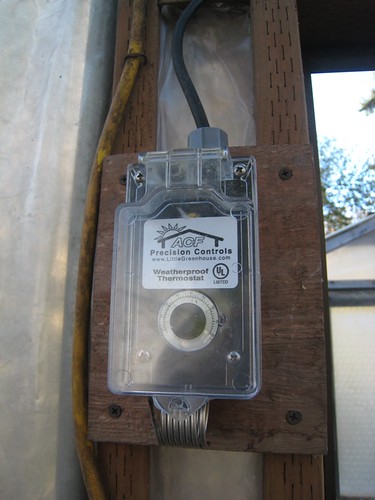
More accurate thermostat for electric heat
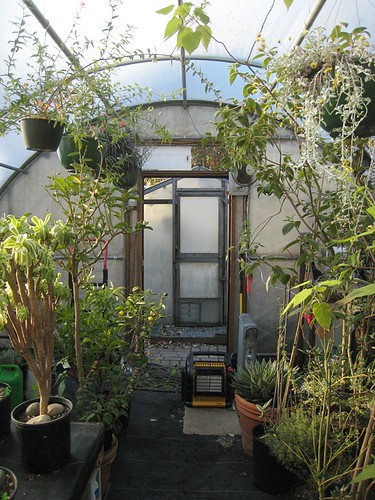
View out towards tropical house
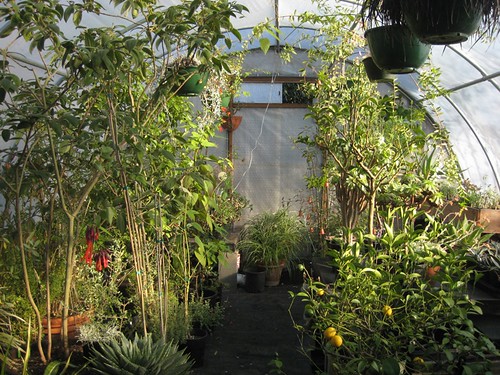
Filled for the winter. He added two purlin rails across the top to hang pots

The endwalls are corrugated fiberglass panels which are insulated with bubblewrap
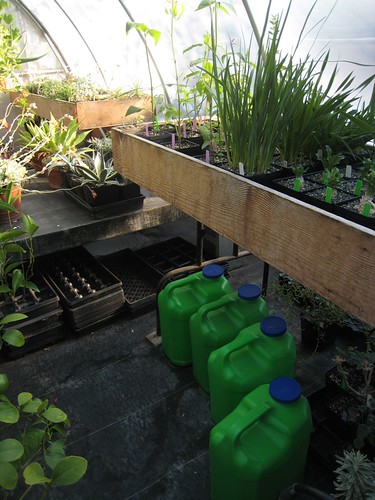
Different style benches. The green containers hold water. We save off the water we run to heat our taps before dishes and cleaning and save in these jugs that were originally cat litter

Agaves protected from the cold
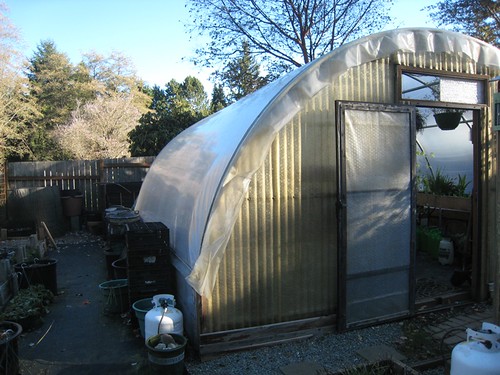
This shows the end walls along with the propane tank for the heater.

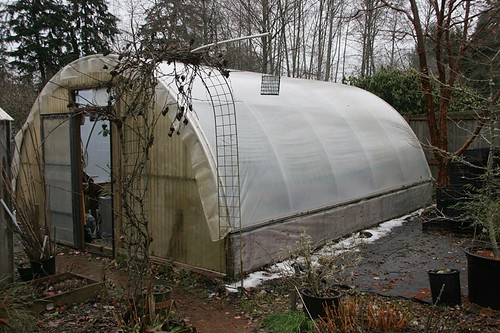
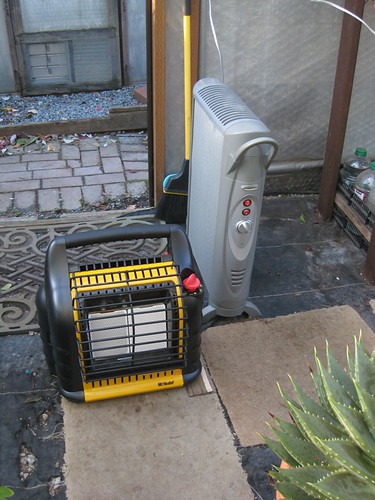


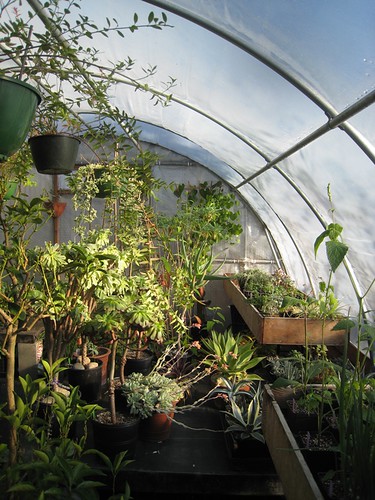
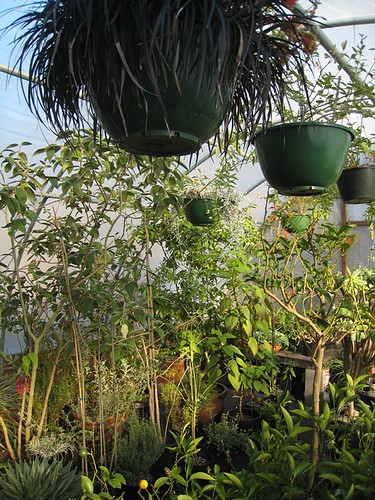
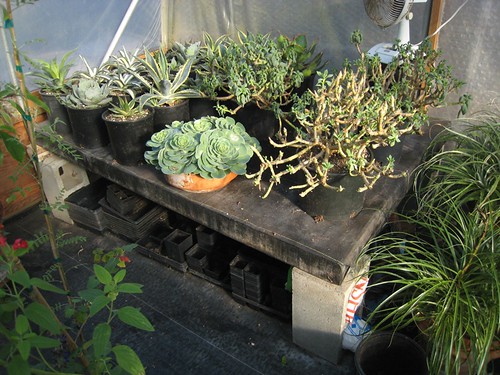
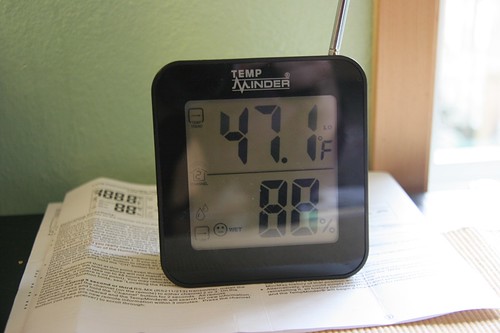
I enjoyed reading about your hoop house, and seeing the photos of it packed with plants. I see you have the same propane heater that I have, and a similar electric one. I’ve contemplated hooking it up to a larger tank. I may do that next year, depending on my experience this year with it. It’s good to know that overwintering my Brugs and Cannas in the garage is a possibility, if I need the space next year. So far, no problem with botrytis, but I do have some woolly aphids.